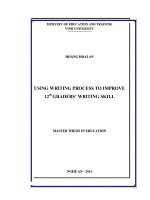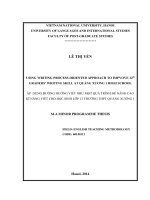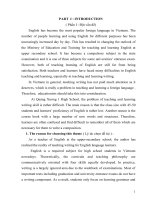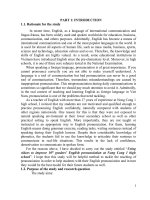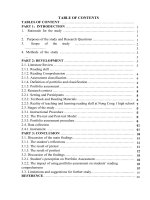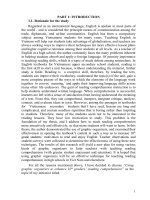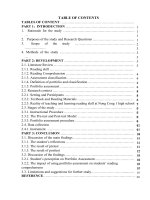Using mind map to improve 10th graders presentation skill in speaking class master thesis in education
Bạn đang xem bản rút gọn của tài liệu. Xem và tải ngay bản đầy đủ của tài liệu tại đây (2.88 MB, 97 trang )
VINH UNIVERSITY
DEPARTMENT OF FOREIGN LANGUAGES
TRAN ANH PHUONG
USING MIND MAP TO IMPROVE
10
TH
GRADERS’ PRESENTATION SKILL
IN SPEAKING CLASS
MASTER THESIS IN EDUCATION
NGHE AN, 2014
2
VINH UNIVERSITY
DEPARTMENT OF FOREIGN LANGUAGES
TRAN ANH PHUONG
USING MIND MAP TO IMPROVE
10
TH
GRADERS’ PRESENTATION SKILL
IN SPEAKING CLASS
Major: Teaching English to Speakers of Other Languages (TESOL)
Code: 60.14.01.11
MASTER THESIS IN EDUCATION
Supervisor: Tran Ba Tien, Ph.D.
Nghe An, 2014
4
STATEMENTS OF AUTHORSHIP
I certify that this thesis is the result of my own study and that it has not been
submitted to any other universities and institution wholly and partially. All
statements of my thesis which are not my own are written in quotation and can be
shown in the list of references.
Nghe An, 2014
Author
Tran Anh Phuong
v
ACKNOWLEDGEMENTS
This thesis would not have been completed without the support of many
people.
First, and foremost I would like to express my deepest thanks to my supervisor
Dr. Tran Ba Tien for his assistance, encouragement and guidance.
I would like to convey my thanks to all my teachers at the Post Graduate
Faculty, Department of Foreign Languages, Vinh University whose fundamental
knowledge about langue teaching and learning is of great importance to the
achievement of my academic study.
Finally, I should like to express the warmest gratitude to my colleagues,
friends, students, especially my beloved family. I feel greatly indebted to them for
their essential help and encouragement
vi
ABSTRACT
It is the fact that speaking, as well as presenting skill, is an important
language skill, however, the teaching and learning English speaking are far
from satisfactory. What are the reasons? This study aims to investigate
students’ and teachers’ attitudes toward presenting skill as well as their
difficulties in learning and teaching the skill in a speaking lesson. The factors
that cause those difficulties are also stated. To achieve the aims of the study,
survey questionnaires for 135 students were designed and used as the data
collection tools. Both qualitative and quantitative methods were employed to
analyze collected results and create a detailed description of the real teaching
context. Once the problems have been identified, some suggestions for teacher
and students to improve presenting skill by using mind map would be given. It
is shown that students have made higher gains in presentation. The result was
recognized by post-task questionnaires done by both students and teachers. The
improvements are also seen in the class observation collections which were
recorded and then tape-scripted. Mind- mapping has been considered an
effective tool for both students and teachers in learning and teaching
presenting skill. This study investigates how mind map can help to solve the
problems with learning and teaching presenting skill as well as teacher’s and
learner’s attitudes toward using mind map as a tool learning and teaching
English.
vii
ABBREVIATIONS
CA : Communication Apprehension
CLT : Communicative Language Teaching
EFL : English as Foreign Language
ESL : English as Second Language
L1 : First Language
L2 : Second Language
viii
TABLE OF CONTENTS
Pages
STATEMENTS OF AUTHORSHIP v
ACKNOWLEDGEMENTS vi
ABSTRACT vii
ABBREVIATIONS viii
TABLE OF CONTENTS ix
LIST OF TABLES xii
Chapter 1
INTRODUCTION 1
1.1. Rationale 1
1.2. Aims of the study 2
1.3. Research questions 2
1.4. Scope of the study 2
1.5. Methods of the study 2
1.6. Design of the Study 3
Chapter 2
LITERATURE REVIEW AND THEORETICAL BACKGROUND 4
2.1. Previous studies related to the research 4
2.2. Theoretical backgrounds of teaching speaking skills 5
2.2.1. Definition of speaking 5
2.2.2. Characteristics of speaking 6
2.2.3. What makes speaking difficult? 7
2.2.4. Aspects of teaching speaking skills in language class 8
2.2.5. Principles of teaching speaking 9
2.2.6. Types of classroom Speaking performance 10
2.2.7. Three stages in a speaking lesson 11
2.3. Presentation 13
2.3.1. What is presentation? 13
2.3.2. Factors affecting students’ presentation 14
2.4. Mind map 20
2.4.1. What is a mind map? 20
2.4.2. Characteristics of mind map 21
2.4.3. Advantages of mind maps 21
ix
2.4.4. How to draw a mind map 22
2.4.6. Activities in teaching with mind map 23
Chapter 3
METHODOLOGY 25
3.1. The research context 25
3.1.1. The participants 25
3.1.2. Textbook 26
3.2. Research methods 27
3.3. Research instruments 28
3.3.1. Questionnaires 28
3.3.2. Interviews 29
3.3.3. Data collection procedure 29
3.4. Data analysis 30
Chapter 4
FINDINGS AND DISSCUSSION 31
4.1. Pre-task questionnaire for students 31
4.1.1. Students’ attitudes toward presenting skill. 31
4.1.2. Students’ interest in presenting 32
4.1.3. Students’ reluctance in presenting 32
4.1.4. Students’ participation in presenting lessons. 33
4.1.5. Factors making students reluctant to present. 35
4.1.6. Factors deterring students’ presenting. 36
4.2. Pre-task questionnaire for teachers 37
4.2.1. Teachers’ attitude toward presenting skill 37
4.2.2. Factors making teaching presenting difficult 38
4.2.3. Time limitation 39
4.2.4. Students’ unwillingness 40
4.2.5. Factors causing students’ unwillingness when presenting 41
4.2.6. Factors preventing students from presenting 43
4.3. Post-task questionnaire for students 45
4.3.2. Question 2: Do you feel mind map easy to use? 46
4.3.4. Question 4: How can mind map help you to feel more confident
when presenting? 48
4.3.5. Question 5: How often do you want to use mind map to present?49
4.4. Post-task questionnaire for teachers 50
4.4.1. Teachers’ interest in using mind map 50
50
4.4.2. Question 2: What can mind map help your students in their
presenting? 51
x
4.4.3. Question 3: How can mind map help your student to overcome
their anxiety in their presentation? 52
4.4.4. Question 4: How often do you want to use mind map to teach
presenting skill? 53
4.5. Some suggestions for using mind map to teach presenting skill 56
Chapter 5
CONCLUSION 60
5.1. Conclusion 60
5.2. Implications 60
5.3. Limitation and suggestions for further research 62
REFERENCES 63
APPENDIX 1 67
xi
LIST OF TABLES
Pages
Table 4.1. Students’ attitudes toward presenting skill 31
Chart 4.1. Students’ interest in presenting 32
Table 4.2. Students’ reluctance to present 32
33
Chart 4.2. Students’ participation in presenting lesson 33
Table 4.3. Students’ opportunity to present 34
Chart 4.3. Factors making students reluctant to present 35
Table 4.4. Factors detering students’ presenting 36
Chart 4.4. Factors deterring students’ presenting 37
Table 4.5.Teachers’ frequency in teaching presenting 37
Table 4.6. Teacher’s difficulties in teaching presenting 38
Table: 4.7. Limitation of time for presenting task 39
Table: 4.8. Students’ chance to present in class 39
Table 4.9. Students’ unwillingness to present 40
Table 4.10. Factors causing students’ unwillingness when presenting 41
42
Chart 4.5.Factors causing students’ unwillingness when presenting 42
Table 4.11. Factors preventing students presenting 43
Chart 4.6. Factors prevent students presenting 43
Chart 4.7. Students’ interest in mind map 45
Chart 4.8. Students’ feeling of easiness to use mind map 46
Table 4.12. What mind map helps student 47
47
Chart 4.9. What mind map helps student 47
Table 4.13. How mind map help you to feel more confident when presenting 48
Chart 4.10. How mind map help you to feel more confident when presenting 48
Chart 4.11.How often do you want to use mind map to present 49
xii
Table 4.14. Teachers’ interest in using mind map 50
Table 4.15. What mind map helps your students in their presenting? 51
Chart 4.12. What mind map helps your students in their presenting 51
Table 4.16. What mind map helps your students to overcome their anxiety 52
Chart 4.13. What mind map helps your students to overcome their anxiety 52
Table 4.17. How often do you want to use mind map to teach presenting skill? 53
xiii
Chapter 1
INTRODUCTION
1.1. Rationale
The English text books which are being used in many high schools now are designed
in 16 units. Reading, speaking, listening and writing skills are equally focused in all units.
However, teaching English by integrating four skills causes many difficulties to teachers
due to shortages of teaching aids such as speakers, video player, teaching methods…
Productive skills like speaking and writing are perhaps the most difficult to teach due to
some certain reasons.
The importance of English in communication is increasingly emphasized
while the traditional teaching method at Vietnam’s high schools focused much
on grammar and vocabulary. Teachers do not pay adequate attention to
speaking and listening skills. They seem to face with an obstacle in improving
learners’ communicative competence. This leads to some problems. Students,
in fact, can be good at grammar, but they have difficulty in speaking. Their
English is not good enough to use in real communicating situations.
Moreover, in speaking lessons, the students are afraid of speaking, they
find difficult to express their ideas, discuss and exchange their thoughts with
their friends. Especially when being asked to make a speech or a presentation,
they often feel confusing as they don’t how to organize and present their ideas
although the ability to present is clearly valuable at every stage of students’
lives. Meanwhile presentation tasks, in which students are required to present
their ideas is an important part in an English speaking class at high school.
That is the reason why tasks aiming to develop presenting skill for students
are designed in all 16 speaking lessons textbook in Tieng Anh 10. Presenting
tasks often introduced in the post-speaking stages where free or less control
tasks are offered.
Actually, speaking lessons cause many difficulties to both teachers and
learners, presenting skill is even much more difficult to achieve due to a
shortages of teaching and learning tools.
1
Mind map which was invented by Tony Buzan is now widely applied in
many fields, including teaching and learning language. It may help students to
take note, learn vocabulary, review the lessons, and logically organize
ideas…. Being aware if the advantages of this tool for students to prepare a
presentation, or a speed, the author do the research with the hope to supply a
useful tool to teachers and studnets
1.2. Aims of the study
The aim of the study are as follow:
- to emphasize the importance of presenting skill in learning English.
- to suggest ways to use mind-map to stimulate the 10
th
form students in Nghen
High School in presentation tasks in an English speaking class.
- to provide a tool for teachers of English to prepare English speaking lessons
at Nghen High school.
1.3. Research questions
The study is to answer the following research questions:
1. What are teacher’s and students’ difficulties in teaching and learning
presenting skill?
2. What are students' and teachers’ attitudes in using mind-map in English
speaking class?
3. What are suggestions for using mind-map in English speaking class?
1.4. Scope of the study
The research is focuses on using mind-map to help 10
th
form graders at Nghen
High School to present in speaking lessons.
1.5. Methods of the study
This study is conducted based on qualitative and quantitative methods.
Comments, remarks, suggestions and conclusions are based on actual researches,
experience, and discussions. Besides, books are used as reference.
Procedure:
- Conducting survey on the students’ learning style, and their problems in
presentation in English Speaking Class.
2
- Giving questionnaires to investigate students’ and teachers’ attitudes towards
mind map as well as teachers’ comments on using mind map to teach presenting in
speaking classes.
1.6. Design of the Study.
The thesis consists of the following main parts:
Chapter 1: Introduction presents the rationale and the scope of the thesis,
defines the aim and objectives of the study. The research questions, methods and
organization are also mentioned in this part.
Chapter 2: Literature Review covers the concepts relevant to the study:
theoretical backgrounds of teaching speaking skills, definition of presentation,
difficulties of presenting skill and theory of mind map.
Chapter 3: Methodology. In this chapter the methodology of the study is
described. The informants such as teacher, students in Nghen high school and
research context are also mentioned.
Chapter 4: Finding and Discussions presents and discusses findings of the
difficulties in teaching and learning presenting skill in Nghen High school and some
suggestions to using mind map to solve these problems.
Chapter 5: Conclusion summarizes the findings and addresses the
shortcomings of the study. It also gives suggestions for further researches and
studies
3
Chapter 2
LITERATURE REVIEW AND THEORETICAL BACKGROUND
This chapter focuses on the literature review and theoretical background of
the study. It includes a number of important theoretical terms related to speaking,
presenting, mind map and previous studies related to the research will also be
mentioned.
2.1. Previous studies related to the research
In high school, speaking is so popular and important skills that there are a
number of researches on how to develop this skill for students. A lot of technique,
activities and tools are investigated and applied. Huong (2013) did a research on
using story telling to develop oral skill for the 8
th
graders in speaking lesson. Yen
(2013) explored the way to use short stories ti improve speaking skill of students at
pe-intermediate level. In her thesis, using role play to enhance English speaking
skills for the 10th graders at Nghi Loc IV high school, Hang (2011) propose
suggestions to develop speaking skill for students at high school. Trang (2013)
suggested the ways to use group work activities in teaching speaking for the first
year accounting students at the western Nghe An vocational school. Huong (2011)
stated the Major factors affecting speaking skill of first year English major students
at Vinh University and some suggested solutions improve their communicative
competence. However, there are not many study on presenting skill which is a
higher level of speaking and a type of speaking performance despite the fact that
presenting is one of important and essential skills to learners of a foreign language.
Tuyet (2009) proposed classroom activities to stimulate 10
th
graders presentation.
Mind map have been applied for some years in Vietnam meanwhile there are not
many thesis on this term. Ngan (2013) suggest how to use mind-mapping to check
students’ reading comprehension. There are many researches on speaking, on how
to develop speaking skills to students. That is reason why there are so many
activities and techniques used to improve speaking skill. However, there is not
much concern on presenting a type of speaking performance which requires a
4
higher level. Mind map has been applied to teaching and learning many subjects in
Vietnam, however, many teachers of English have not made the use of this useful
tool in teaching English. Mind map which may be very helpful to teaching and
learning such difficult skill as presenting, but up to now there no investigation on
this.
2.2. Theoretical backgrounds of teaching speaking skills
2.2.1. Definition of speaking.
It is clear that speaking is the main and the most popular means of
communication of human. There are many definitions of speaking: According to
Byrne (1976), “speaking is a two-way process between the speaker(s) and the
listener(s) involving the productive skill of speaking and the receptive skill of
understanding.” (p.8). In this two-way process, both the listener and the speaker
have a positive function to perform: the speaker has to encode the message
conveyed in appropriate language, while the listener has to decode the message.
And at the same time, the speakers’ prosodic features such as stress and intonation
which accompany the spoken utterances and form part of its meaning and his facial
and body movements help the listener
In Brown’s view (1983, p.19) “speaking is an interactive process of
constructing meaning that involves producing, receiving and processing
information.” The form and meaning of this process depend on the context where it
occurs, including the participants, their collective experiences, the environment, and
the purposes of speaking. Speaking involves not only learners’ability to produce
specific points of language, such as grammar, pronunciation, vocabulary (linguistic
competence), but also their understanding of when, why and in what way to
produce language (sociolinguistic competence).
Chaney (1988, p.13) defines that “speaking is the process of building and
sharing meaning through the use verbal and non-verbal symbols in a variety of
contexts”.
5
Scott (1978, p.18) states that “speaking can be typified as an activity involving
two or more people in which the participants are both hearers and speakers having
to react to what they hear and make their contribution.” Speaking requires the
participating of both hearers and listeners so that they can achieve in the interaction
and interpret what is said to them.
Different researchers have different concepts of speaking, however, they all
agree with one very important feature of speaking, that is a two way process
between the speaker and listener.
2.2.2. Characteristics of speaking
Martin Bygate (1997) point out that when we are speaking to the person who is
in front of us, he or she can put us right when mistakes are made. He or she can also
generally show agreement or disagreement and understanding or incomprehension.
While talking, speakers need to take notice of the other and allow listeners chance to
speak. It means that we take turns to speak.
Brown (1983) and her colleagues show that a listener helps a speaker to
improve his/her performance because being a listener gives learners models to
utilize when acting a speaker. In addition, being a hearer first helps the learner
appreciate the difficulties inherent in the task. It is clear that giving a speaker
experience in a hearer’s role is more helpful than simple practice in tasks in which a
speaker is having real difficulties in appreciating what a particular task required.
Martin Bygate (1997: p.24,25) suggested that conversation can be analyzed in
term of routines, which are conventional ways of presenting information. As far as
we have known, there are two kinds of routine: “ information routines” and “
interaction routines”.
Information routines frequently recur information structures, including stories;
descriptions of places and people; presentation of facts, comparisons, instructions.
Interaction routines are the ones based not so much on sequences of kinds of
terms occurring in typical kinds of interactions. These routines thus can be
6
characterized in broad terms including the kinds of terms typically occurring in
given situations, and the order in which the components are likely to occur.
By and large, the students can be much more confident in speaking English
with clear understanding and governing these skills. The oral skills, however, are
dependent on the knowledge of language they learn such as grammar, pronunciation
and vocabulary. In addition, students rely on common conventional expressions for
communicating specific meanings, particularly on the language environment. It is
unedited that practice in classroom might not be similar to oral communication
outside classroom. In a foreign language classroom, practice is rather simple and far
from real life.
For instance, contents of communication topics in class are decided by teacher,
whereas outside classroom speakers can express freely what they want. The exact
content is unpredictable. Regarding the reason for communicating in classroom,
learners speak to practice speaking, to get good marks, but in real life speakers have
their own reasons for their speech. Hence, the teacher should reckon the differences
of the two situations to help learners speak English naturally and make their
speeches sound native.
2.2.3. What makes speaking difficult?
According to Brown (2001, p.270) the following features of spoken language
may make a speaking lesson difficult.
Clustering is the first difficulty. Fluent speech is phrase not word by word.
Learners can organize output both cognitively and physically through such clustering.
There are several ways to express or to transfer an idea, information to the hearer; this
is because of the redundancy of language, which gives the speaker an opportunity to
make meaning clearer. Learner can capitalize on this feature of spoken language
Reduced form, which includes contraction, elisions, reduced vowel, etc…,
forms special problems in teaching spoken English. Students don not learn
colloquial contraction can sometimes develop a stilted, bookish quality of speaking
that in turn stigmatize them
7
Colloquialism, which is often used in everyday conversation in very informal
situations, appears both in monologues and dialogues. If learners are only exposed
to standard English and / or “ text book” language, they sometimes have difficulty
in understanding and producing words, idioms and phrases of colloquial language
Stress, rhythm and intonation are different from language to language. This
is the most important characteristic of English pronunciation because the stress-
timed rhythm of spoken English and its intonation patterns convey important
massages. But the fact that learners of English often find it difficult to pronounce
English words, to stress the right syllables, to follow the stress- timed rhythm and
intonation patterns of spoken English.
The greatest difficulty that the students face in learning to speak originates
from the interactive nature of most communication. Engaged in the process of
negotiation of meaning with many discourse constraints, learners have to do the
complex task of choosing what to say, how to say, when to say, etc. Learners are
also affected by their interlocutors’ performance.
2.2.4. Aspects of teaching speaking skills in language class.
2.1.4.1. Teaching interactional skills
It is certain that the ultimate objective of language learning is the ability to
communicate competently in that language. Richard, Platt and Weber (1985), (cited in
Nuna., 1999) characterized four dimensions of communicative competences as follows:
- Knowledge of the Grammar and Vocabulary of the language
- Knowledge of the rules of speaking (e.g. knowing how to begin and end
conversations…)
- Knowing how to use and respond to different types of speech acts such as
requests, apologies, thanks, and invitations;
- Knowing how to use language appropriately.
Accordingly, in the speaking class, teachers need provide their students with
interactional skill, for example, how to open and close conversations, how to make
turns and interrupt, and how to respond appropriately, ect.
8
2.2.4.2. Accuracy and fluency
Accuracy: When we say someone speaks English with accuracy, we mean
they speak English without or with few errors in grammar, vocabulary and
pronunciation.
Fluency: Fluently speaking means being able to communicate one's ideas
without having to stop and think too much about what one is saying.
Scrivener (2005, p.160-162) notes that accuracy is the ability to speak
correctly without making serious mistakes and therefore a greater use of instant
teacher's correction within a speaking activity is appropriate. On the contrary,
fluency is the ability to speak confidently without irrelevant pauses or hesitation,
however, often with making major mistakes. In this case, instant correction may be
inappropriate and could interfere with the aims of the speaking activity. According
to Hadfied (2008, p.107), learners learn to speak by speaking, which means they
need to be given plenty of opportunities for communicating in different situations
and on different topics. “To develop fluency, learners need as much practice as
possible”, which means organizing speaking lesson to give them as much
opportunity to speak as possible and getting students learners to work in pair or
groups rather than teachers-student interactions.
2.2.5. Principles of teaching speaking
Output and input: when students produce a piece of language, feedback from
their interlocutor will act as input based on that they modify their output. Such input
can come from the teacher as feedback or prompters.
Texts: texts offer students a model to follow, especially when they are working
on specific functions of language like agreeing, apologizing, refusing, and so on.
Texts can also act as stimuli as a lot of language production grows out of texts that
we see or hear. A controversial reading passage may be the springboard for a
discussion. (Listening to a tape in which speakers tell a story or opinion may
provide necessary I stimuli for students to respond based on their own experience).
9
Reception as part of production: in many situations, production can only
continue in combination with the practice of receptive skills. Thus conversation
between two people is a blend of listening and speaking; comprehension of what is
said is necessary for what the participant says next.
Production enables reception: when students try to speak in certain situations
or within certain genres, they are better attuned to understanding other people
speaking in the same context. In this case, oral production works in a way that helps
students with their listening comprehension. (Harmer, 2001)
To motivate students in English speaking lessons, it is suggested that the
below principles should be apllied.
- Give students practice with both fluency and accuracy:
- Plan communicative tasks that are based on the concept of information gap
- Provide opportunities for students to talk by using group work or pair work,
and limiting teacher talk
- Plan tasks that involve negotiation of meaning
- Design classroom activities that involve guidance and practice in both
transactional and interactional speaking.
2.2.6. Types of classroom Speaking performance
Brown (1994, p.271-274) proposes six categories applied to the kinds of oral
production that students are expected to carry out in the classroom:
- Imitative: takes a very limited portion of classroom speaking time when
learners are practicing an intonation contour or trying to pinpoint a certain vowel
sound, etc.
- Intensive: includes any speaking performance that is designed to practice
some phonological or grammatical aspect of language.
- Responsive: is short replies to teachers or student initiated questions or
comments. These replies are usually sufficient and do not extend into dialogues.
- Transactional (dialogue): is carried out for the purpose of conveying or
exchanging specific information. Conversations, for instance, may have more of a
10
negotiative nature to them than merely responsive speech. Such conversations could
readily be part of group work activity.
- Interpersonal (dialogue): carries out more for the purpose of maintaining
social relationships than for the transmission of facts and information. These
conversations are a little trickier for learners because they can involve some or all
the following factors: a casual register, colloquial language, emotionally changed
language, and slang, etc.
- Extensive (monologue): students at intermediate or advanced levels are
called on to give extended monologues in the form of oral reports, summaries, or
perhaps short speeches. Here the register is more formal and deliberative. This type
of speaking is considered as presenting performance in the textbook Tieng Anh 10
and it often focused at the post-speaking stage of a speaking lesson.
These above six categories of Brown are highly valuable in offering a guide in
working out the types of classroom speaking performance. The teachers should
consider these points when teaching speaking skill.
2.2.7. Three stages in a speaking lesson
2.2.7.1. The pre-speaking
In this stage, teachers play a the central role. They provide students with
information because they know English, select materials to teach and present the
material so that the meaning of the new language items as intelligible and
memorable as possible as while the learners are motionless. So far, oral materials
are written mainly in two forms in every course book. They are dialogue and prose.
And obviously these two forms must be presented in defend ways.
According to Byrne (1991, p.22) introduction of the procedure in which the
ten different steps are used to present a dialogue. They are:
• Establish setting by using pictures. At this phrase English should be used as
much as possible,
• Draw out learners’ experience related to situation.
• Explain some key words.
11
• Set listening task by asking key information of the dialogue.
• Ask learners to listen without looking at the books.
• Allow learners to have a look at their books when necessary.
• Ask the learners to listen and repeat
• Ask learners to pick up difficulties (good chance for learners to soak) and
explain difficulties.
• Ask them to practice( Role- play)
• Ask learners to dramatize the dialogue.
It has been known that this procedure is perfectly and logically arranged.
However, it is dependent on the learner’s competence so some steps can be left out.
It is quite hard for Vietnamese learners to conduct the step ten because they are
generally shy and time is limited. Nine other steps are used to present a prose.
2.2.7.2. The while-speaking
Unlike the presentation phase, in this stage learners have to do most of the
talking. Teacher provides maximum amount of practice. Practice is usually in the
form of activities or exercises to improve fluency of speaking. Pair work or group
work are used in this phase. According to Hadfield (2008, p.108) in the during-stage
(also while-speaking), for preparation, speaking tasks should be set up with clear
instructions. Learners work in pair a alone to brainstorm ideas and plan what to say.
Learners may work in pair or groups to carry out the task. While doing this teacher
should circulate, listening to the learners to see how they are doing. Teacher can
make note of errors and area of difficulty for feedback later.
2.2.7.3. The post-speaking
Learners need to be let to speak English freely at this phase. A real chance to
speak English takes place when the learners are able to use English naturally for
themselves, not for their teacher. Group work plays an important part in making
learners practice speaking. By doing group work, all learners can have chance to
participate in task. Time can be saved and learners seem more confident.
12
